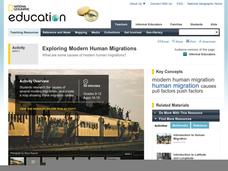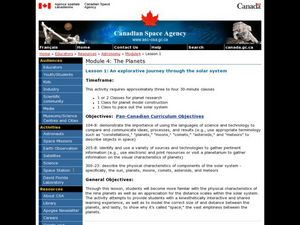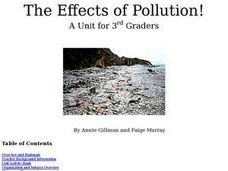Curated OER
History of the X-Ray
Seventh graders discuss the history of the x-ray machine. In this social science instructional activity, 7th graders understand how a x-ray machine works. Students recognize that there have been many improvements to the x-ray machine...
Curated OER
Conflict Resolution in the World Today: Introduction to Current World conflicts, their Antecendents, the Progression, and their Potential Conclusions
Young scholars write a paragraph describing a conflict they had with a friend or a family member and a paragraph explaining how it was resolved. In this social science instructional activity, students share their paragraphs with a...
Curated OER
The Gingerbread Person
Students discuss gender bias and stereotyping. In this social science lesson, students read the book "The Gingerbread Boy" and discuss why it is a boy. Students then write their own story changing it to a gingerbread girl and a female fox.
Curated OER
Around the World
Young scholars discuss the major geographical and cultural differences in the world. In this social science instructional activity, students pretend they are traveling and research information about where they wish to stay by finding...
Curated OER
The United States and the Soviet Union were Engaged in a Cold War
Students work together at figuring out the definition for what cold war means. In this social science lesson, students listen to "The Butter Battle Book" by Dr. Seuss and recognize how this story relates to the cold war between the...
Curated OER
TV Tells it All
Students discuss the concept of gender bias and stereotyping. In this social science lesson, students determine what the influence of television on gender roles represents and compares the chage in gender roles of today to those of their...
Curated OER
Is the Brady Bunch Biased
Learners examine gender bias on television and in the movies. In this social science lesson, students watch various shows and when an instance of stereotypical behavior, or gender bias situation occurs, learners think about the problem....
National Geographic
Exploring Modern Human Migrations
Using maps, images, websites, and handouts, learners work to understand the nature of human migrations. They compare and contrast human migration from the past to the present, identify causes for migration, and trace migration routes on...
Curated OER
Can You Adapt?
Using the Montana State Quarter, learners engage in activities designed to help increase their understanding about how animals must change their social and physical behaviors in order to adapt to their environment. Excellent worksheets...
Curated OER
Harry Potter: Middle Grades Activity
Students identify inferred and recurring literary, cultural and social themes such as bravery, loyalty, friendship and the notion of good vs. evil.
Curated OER
In your Science! - Merging Art and Science
Ninth graders reflect on what they have learned throughout the unit. In this Science instructional activity, 9th graders demonstrate how working together can produce an informative useful project.
Curated OER
Food & Science - How Healthy is Your Diet?
Learners experiment with various foods to determine fat and starch content. They rub jam, peanut butter, bananas, and other foods in a small circle on a piece of paper, and observe the results. If there is a high fat content in the...
Curated OER
Lesson 4 Activity 1: Mapping the Third Dimension
Students work in pairs to construct a simple stereoscope.
Curated OER
Bee Pollen Popular
The world would be a much different place without the help of pollinators. Read about the important role bats, hummingbirds, and various insects play in plant reproduction, exploring the interdependence of living things in an ecosystem....
Curated OER
Paul Robeson: 20th-Century Renaissance Man, Hero In Any Century
Students study the life and times of actor Paul Robeson. In this social activism activity, students research primary and secondary documents to create multi-media presentations featuring Paul Robeson's life and political activism.
Curated OER
Just "Kid"ding Around: The Truth About Goats
Students examine goats, and read a book based on their history. In this animal lesson, students discover the history of the goat, and complete several activities based on the students' knowledge of the animal.
Curated OER
An Explorative Journey Through the Solar System
Students explore space science by creating a planetary model in class. In this solar system instructional activity, students identify the many planets and moons that make up the solar system and decide on one entity in which to research....
Curated OER
Integrating Science and Literature: Life as We Knew It
Supplement your science units with science fiction novels!
Curated OER
Sunken Treasure
Go on a treasure hunt with your language arts class! They read "Treasure Hunt" and "Exploring the Titanic," then create a final product by taking part in an unusual art activity.
Curated OER
Poetry Through Digital Storytelling
Bring digital storytelling to your language arts class! To begin, learners select their own topic, such as a poem that reflects a life experience they had or a historical figure who interests them. Then they work to create a storyboard...
Curated OER
The Effects of Pollution!
Learners examine pollution and how it affects the environment. They discuss how human activities lead to more pollution. They talk about the importance of recycling. There is a skit, resource links, and activities provided to make this a...
Earth Day Network
Filtering Water
See the water filtration system up close with a fun science experiment. Young scientists work for several class periods to design a water filter using household objects, and then decide which filter material would be most effective in...
Anthropological Association
Race: Teacher Guide: Race
How has the concept of race changed over time? Explore the genetic, cultural, and social aspects of race through a series of impactful activities. Scholars discover how race is influenced by inherited traits, examine census records to...
Curated OER
Dancing Flamingos
Students perform a number of activities that mimic flamingo actions and displays. The class discusses why animals behave in certain ways, and how behavioral adaptations help animals to survive.

























